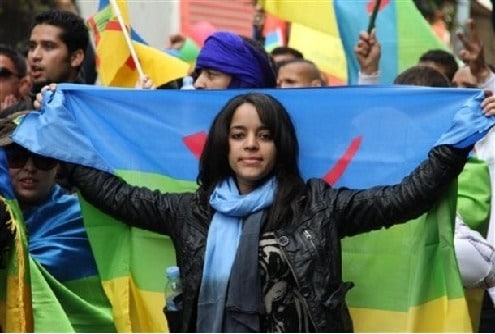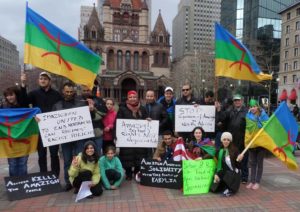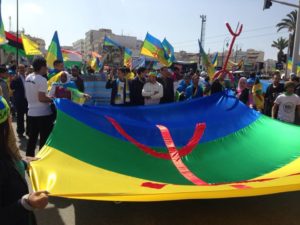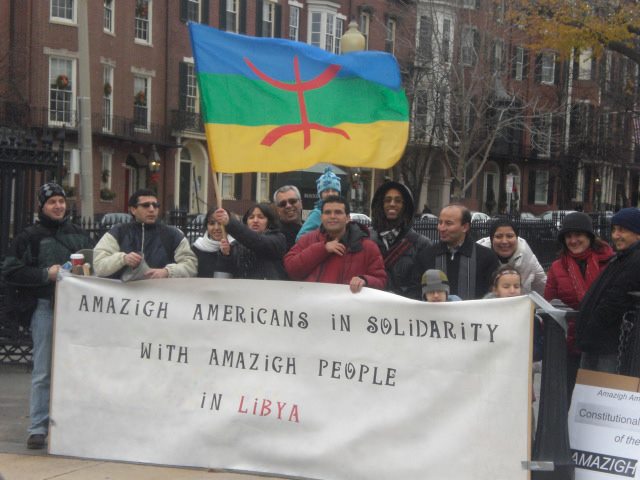By Helene Hagan,
Presented at the United Nations, 2002 P.I.P.E. Conference in preparation of the First Session of The Permanent Forum on Indigenous Issues.
In this presentation, I will first introduce the Imazighen and the Amazigh culture of the thirty million or so autochthonous people of North Africa. I will review the various local, national and international branches of our fast growing international movement, and the manner in which means of communication and international alliances have formed and serve the communities of base in North Africa and sub-Saharan countries, the “Diaspora” of Europe, and the Amazigh communities of Canada and the United States. In addition, the presentation will summarize the various technologies (use of the internet, digital technology and emerging forms of expression) with which the Tazzla Institute for Cultural Diversity has worked in the past ten years in order to publicize various aspects of the Amazigh culture and inscribe this culture in the record of history, in the United States and abroad.

THE TAZZLA INSTITUTE: Functions and Role.
I am the President of Tazzla institute for Cultural Diversity and a native of Morocco. My mother was a native of Algeria, and my maternal roots are Kabyle, as far back as our family record goes. I grew up in the interior of Morocco where I absorbed a lot of my early knowledge through the ways and traditions, which are Moroccan, and a certain perspective and non-formal knowledge through an Algerian mother. The TAZZLA INSTITUTE was initially created to support American Indian groups and issues, environmental issues, and subsequently Amazigh issues by its activities. In 1997, the Institute began a series of television programs, called “Tamazgha, Berber Land of Morocco,” following a trip to the south and the pre-Sahara region of Morocco. Ten half-hour television programs are available, which are the only Amazigh television programs available in the United States. They have been followed by other programs on Amazigh gatherings in the US, and recently to bring to the attention of American viewers the struggle of our people throughout North Africa. (Amazigh News, 2001-2007) In 1998, the Institute became aware of an Amazigh Internet Forum, the Amazigh-net, which opened up fields of communication, participation, research, and advocacy impossible before. We came immediately in touch with the World Amazigh Congress (CMA) which was preparing its first International World gathering in Tafira, Canary Islands. Members of the Institute traveled there not only to become part of this international movement and meet a number of its representatives, but also to videotape the whole event for the CMA. A short, edited version of this momentous event is made available through the television program entitled “Amazigh Identity.” Since those first steps, which aimed at educating the American public about Amazigh issues and human rights and a little known culture, the Institute has progressed on the national and international levels, through the agencies of links with other Amazigh organizations, Internet sites journals and magazines. The TAZZLA INSTITUTE became a member of the Amazigh International coalition for the Defense of Human Rights, and has sponsored the NGO organization OVD Tidhelt of Niger in the United States, as “Engaged Partner ” to that Tuareg grass-root organization since 1999.
THE AMAZIGH NETWORK: Local, national, and international
1. The social structures of the Amazigh Movement
The Amazigh society distinguishes itself by democratic rule and the traditional social structure of the Assembly of Elders, where counsel is taken for common action in all matters, at the level of the village, then the valley, and thirdly the region. When matters become of great importance to the people, this Assembly of elders becomes a general alliance of the Councils where deputies from the village have elected a representative to the valley and to the regional level become national Council members. Thus, on a national level, spokespersons representing the group, the valley and the villages of the valley are empowered to make decisions. In today’s world, these councils have taken the form of “cultural associations” which sprang in the underground of a nation where oppressive policies forbade free speech and right of assemblies for Imazighen. They became the focal points of cultural survival and a struggle, which has gone from the base of the people in rural areas, to the valley or locality level, then to national headquarters. A good example of such structure and function is the TAMAYNUT Association in Morocco, with over thirty branches at the local level, and a headquarter in Rabat, the royal capital of the kingdom of Morocco. Similar cultural associations, but with less spreading influence are AMREC (Moroccan Amazigh Center for Research and Education) and the Association of the University of Agadir, with membership from various regions of Morocco. Similar cultural associations have sprung throughout Europe in various countries. With over a million and a half “Berbers’ (primarily Kabyles of Algeria) in France, cultural associations in France abound. But there are very active organizations in London, the Netherlands, Belgium, Italy, Germany and Spain. There is a vibrant Kabyle community of Imazighen in Canada and in the United States, membership to A.C.A.A., The Amazigh Cultural Association in America, is the oldest association.
2. The international alliances of the Amazigh Movement

Representatives of TAMAYNUT have acted on the international level, and are active in an International Amazigh Coalition, which includes a number of associations from various countries of Africa, such as Tunisia, Algeria, Morocco, the Canary Islands, Mali, and Burkina-Faso. (C.A.I.D.D.H) The international coalition, including the TAZZLA INSTITUTE of the United States as one of its members, is headed by Abdenour Benyahya, and is an NGO working out of Geneva, Switzerland. Representatives of TAMAYNUT are equally active with the World Amazigh Congress, (C.M.A.) another international NGO organization of the Amazigh Movement, headquartered in France, which has met with Mary Robinson, Human Rights Commissioner, and representatives of the European Parliament, with the support of The Green Party of Europe. Both C.A. I.D.D.H and C.M.A. participated in the recent global conference Against Racism and Discrimination, which took place in South Africa last August 2001.
3. Means of Communication in networking and alliance formation:
The AMAZIGH MOVEMENT has the peculiar characteristic of numbering a large number of communications engineers in its midst. In the United States, there are indeed many communication specialists, and Amazigh students in American universities who will enter the ranks of electronic communication specialists outnumber all other fields. The primary impetus came from the set-up of the Amazigh-net, a Forum devised by a member of ACAA, an engineer in communication presently living in San Diego, California, and the tremendous growth of this internet exchange used for news dissemination, cultural exchanges, and the call to various alerts, petitions, etc. The Amazigh-net has been at the forefront of an explosion of means of communication for the Amazigh Movement. In the last ten years, numerous sites began to open, such as Kabyle.com, Berberworld.com, and in the United States W.A.A.C in Washington, the World Amazigh Action Coalition, which has played an important function in education, information dissemination, and activism. Libyans got into action more recently and created Libyamazigh.net. The Assembly of Elders of Kabylia, Algeria opened their own sites to inform Imazighen around the world of their moves and decisions concerning the grave situation in Algeria. After the assassination of Lounes Matoub, the great singer/advocate of the Algerian Amazigh movement, the Lounes Foundation opened a web site. More recently, a community of the Aures Mountains of Algeria announced the opening of a very interesting new site.The TEMUST Tuareg site set up by Abdahali Attayoub of Lyon, France has already a certain longevity and promotes Tuareg culture and Human Rights Publications in Berber language, Tamazight, began to open their doors, as press restrictions began to weaken in Morocco. Still, as the Moroccan government does not financially support either press, radio and television other than Arabic ones, the funds necessary to the healthy operation of these nstruments of communication are minimal, private, and often, lacking. Finally, one of the latest born, but not the least, as it allowed rural people of Algeria and Morocco to equip themselves with satellites and tune-in to their favorite Amazigh television programs, is BRTV, the French Amazigh Television and Radio Channel which is the jewel created by a French Berber Jurist, the same problem of financial viability affects BRTV which relies on membership donations for operation. A list of numerous other sites can be obtained by using a search engine for “Berber” or “Amazigh” sites.

The Amazigh Movement and other Indigenous peoples
We have already noted that The Amazigh Movement has networked with numerous other indigenous organizations through its NGO groups at the United Nations, for the case of C.A.I.D.D.H. and IPAAC primarily with African groups and coalitions, in the case of TAMAYNUT and the CMA with other autochthonous people through the Working Group on Indigenous People, and personal friendships with American Indian representatives of the United States and Canada. In the USA, Tazzla Institute has worked at the United Nations for several years, participating in a joint NGO project under the UNESCO Culture for Peace Program, “Creating Peace Through the Arts.” Under this project, Tazzla Institute has introduced a number of speakers at various occasions in the past five years. In 2006, it brought Dounia BenJelloun, the director of the newly created Dounia Productions of Casablanca, Morocco to introduce a remarkable documentary filmed by a famous French film director, Jacques Renoir, titled “The Amazigh Renaissance” on the teaching of Tamazight by means of the ancestral script of Tifinagh in rural schools of Morocco. The TAZZLA INSTITUTE also has a history of working with American Indian groups, among which the International Indian Treaty Council, an NGO which recently obtained an Eco/Soc status at the United Nations. The Tazzla Institute has fostered ties between this organization and the Amazigh Movement. Recently, for the first time, a United Nations Liaison Officer for IITC requested through the agency of the Tazzla Institute documentation from the Amazigh Movement for an intervention including Imazighen.
Uses of technology in gathering and diffusing information locally, and globally.
Tazzla Institute for Cultural Diversity instituted the project Amazigh Video Productions to create documentaries on the Amazigh culture and Imazighen which have been aired in California, several events in the US. as well as in Morocco. The 11 programs which began to air in San Francisco in 1998 as Tamazgha, Berber Land of Morocco, were also shown on community Television channels in Los Angeles, and are presently available in digital format to use in classrooms and for other cultural presentations. In addition, Amazigh Video Productions created another series of programs from its Los Angeles headquarters (2001-2007) reporting on important Human Rights issues relevant to Algerian, Moroccan and Saharan groups under the title of “Amazigh News” The list of those half-hour reports is available on our web site at http://www.tazzla.org , video section. International contacts realized through the medium of the internet and linking with other web sites has brought Helene Hagan and Tazzla Institute in touch with a number of individuals and groups willing to help the Amazigh cause. In 2005-2006, a book was created to help the Desert Schools of the Sahara in Niger, entitled “Tuareg Jewelry, Traditional Symbols and Patterns” (XLibris, 2006.) This book made the most of electronic technology by gathering information and digital photography on the internet, with the collaboration of a number of helpful individuals and organizations interested in helping the Amazigh cause. The book is published on demand through the latest cutting edge technology provided by the publishing industry, by Xlibris, a branch of Random House Publishers, and is distributed through amazon.com. Tazzla Institute has also created a special web site to introduce the book to potential readers and academic use at http://www.tuaregjewelry.org
CONCLUSION
The structures of the Amazigh Movement and the networks in which it inserts itself are both regional – Africa, Europe, Northern America and trans-regional. The foundation of the Movement is the Amazigh individual, enamored of freedom and always ready to struggle for democratic institutions. The people come together at the village level, and look to alliances, which have been in the long traditional past of our culture viable instruments of self-rule. These structures are used to delegate representatives to larger social contexts, and finally, in the age of global communication, to interact not only with other groups of Imazighen, but with indigenous people of Africa and the world at large. The ability to network outside countries of North Africa which until recently were under the rule of Arabic powers intent upon suppressing Amazigh expression without possibility to inform and be informed by outside opinion, has helped the Amazigh Movement in untold ways. In turn, the freedom of expression obtained outside the traditional territory and the growing use of a global internet use and network have had incalculable impact upon the people at home, their determination to obtain the most basic rights, and the conduct of official regimes toward these populations.
[author image=”https://scontent-lga1-1.xx.fbcdn.net/hphotos-xft1/v/t1.0-9/10672227_1064723853552869_4645386693483305958_n.jpg?oh=e56d01aae46ffa44251faa85a5744ac3&oe=565A6B59″ ]Helene Hagan is a North African Ethnologist. She holds a License-es-Lettres in American Civilization from the University of Bordeaux, France, and two Master’s Degrees from Stanford University, one in Linguistics and another in Cultural Anthropology.She is the Executive Director of Tazzla Institute for Cultural Diversity, Los Angeles[/author]

